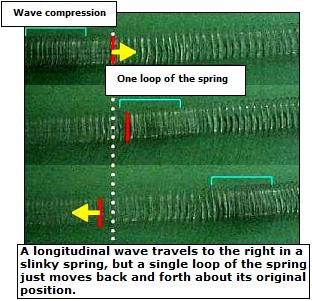A Slinky can show two different types of waves - longitudinal and transverse.
Teachable Topics:
- oscillations & waves
- frequency & wavelength
- music and sound
Theory:
Mechanical waves are waves which occur in matter. A disturbance in one part of the medium will travel to other parts of the medium, even though the actual particles of matter don't stray far from their original positions. Among mechanical waves, we distinguish between two types: longitudinal waves and transverse waves.
Transverse waves are what we most easily recognize as "waves". Ripples in water, vibration of a piano string, and the motion of the bars on the wave machine are all examples of transverse wave motion. In a transverse wave, the motion of the medium is perpendicular to the motion of the wave. To clarify, in a water wave, the actual water molecules move up and down while the wave moves horizontally.
Longitudinal waves, in contrast, are waves in which the medium moves back and forth in the same direction as the motion of the wave. Sound waves are of this type.


Apparatus:
- a slinky toy
Procedure:
- Lay the slinky down on the ground and push it back and forth lengthwise to make longitudinal waves.
- To make transverse waves, shake the slinky back and forth perpendicular to the length.



